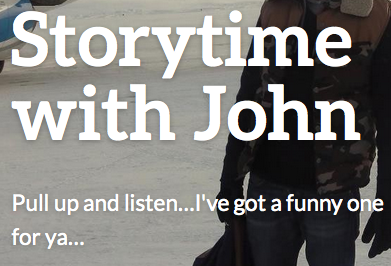Does your blog attract embarrassingly few readers?
And do you struggle to convert any of them into loyal subscribers?
The fact is, once you learn how to start a blog, even if your content rocks, you could still be driving people away by neglecting one simple thing.
If a key element on your blog is either inadequate — or missing entirely — visitors could feel confused and leave.
It may stop people who find your site with a search from clicking through and checking you out, too.
I’ve been reviewing scads of blogs lately, helping writers set them up to earn better, and I’ve found that one blog element is a consistent problem.
The tagline.
Your Readers Need You to Give Them a Sign
One of the first places your new visitors look is up in your header. They’re feeling a little awkward, because they don’t yet know this virtual place. They’re hoping your blog’s title and tagline will fill them in.
Your tagline is a key piece of directional signage on your blog. It’s like one of those big freeway signs that indicates what attractions you’ll find if you exit at the next off-ramp.
Don’t you hate when those are unclear, and you end up in the wrong town, or you can’t find the fairground? I personally loathe getting lost.
Imagine your new blog visitor looking up at your header — your road sign — and wondering, “Am I in the right place? Is this blog really for me?”
If your tagline is either non-existent, a random statement, overlong, or vague, your reader can’t tell if your blog is really for them. And confused visitors are visitors who leave, often never coming back.
Why Big Blog Taglines May Have You Confused
Part of the problem is that bloggers get inspired by the hugely popular blogs they see — and copy them. But taglines are one of those situations where you, as a newbie, can’t do it the way the big guys do.
When you’re Gizmodo, for instance, you can do something funny or random with your tagline. (Theirs is: “We come from the future.”)
You can also have no tagline at all, because everybody already gets it. If you’re, say, Mashable. Other big blogs with no taglines visible on their headers include Engadget, Cheezburger, Jezebel, Deadspin, and Kotaku.
That doesn’t mean you should have no tagline.
When you’re a new blogger trying to build an audience and not an internationally known brand name, your tagline is a critical piece of real estate for communicating with both readers and search engines.
How can you construct a tagline that helps your blog attract just the sorts of readers you want and turn them into loyal subscribers so you can eventually make money blogging?
There are three effective ways a good tagline can attract new readers and help them quickly understand what you’re all about:
1. Refine the Topic
The tagline goes beyond the information we get from your blog name. If that name is a bit inscrutable, the tagline explanation is completely key.
Sometimes the tagline helps narrow down the topic, as on Gail Gardner’s Growmap. From that title, I’m not quite sure what type of growth we’re talking about, but the tagline spells it out for me:

Aha! This is about business growth. If I’m a business owner, I’m sticking around. If I was looking for personal enlightenment tips instead, I move on.
Other times, the tagline signals a broader scope and includes readers who otherwise might have assumed the blog wasn’t for them.
Take Tiny Buddha, for instance. Hearing that blog’s name makes me think that maybe this site is just for Buddhists. But their tagline welcomes a broader group of readers:

Whose life isn’t complicated these days? With those five powerful words, they’ve made this a blog for nearly everyone looking for insights and stress relief.
Many blogs are named after the author. In these cases, the tagline is super-critical in defining your topic, as you see here:

This one’s really clever — because who doesn’t think of themselves as smart? Steve gets everyone saying, “Hey, that’s me!”
Which brings us to the next key aspect to incorporate into your tagline:
2. Include the Reader
When they land on a new blog, one of the big things readers want to know is, “Is this blogger writing for people like me?” If not, they’re outta there.
With the mommy blog Outnumbered 3 to 1, for instance, we don’t quite know what the blog topic is from that headline. But the tagline tells us who the reader is:

Many blog names are flat-out inscrutable without their tagline, as with this legal blog:

Aha! Now I know that if I’m someone who’s interested in the intersection of crime and the law, this blog is for me.
Many big blogs leave the reader out of their tagline. For instance, The Huffington Post’s is “Inform. Inspire. Entertain. Empower.” But as a smaller niche blogger, it’s vital that you let your readers know right away that you get who they are, and that you’re writing about what they need to know.
Many bloggers don’t include the reader in their blog tagline, I’ve found, because they have yet to crystallize in their own minds who that reader is.
If this is you, stop now and create a profile of your target reader. You can’t grow your blog without knowing your audience. Stop saying your blog is “for everybody, really.” No successful blog is like that.
Once you have a picture of your reader in mind, see if your tagline would speak to that reader. If not, rewrite it until it does.
3. Show Your Personality
Your tagline is also the ideal place to give us a sense of your writing style. Will we get humor, snarkiness — what’s the tone here?
For instance, the blog of writer John Lee Taggart, Storytime with John, helps you get the drift of his writing approach with the conversational language and content of its tagline:

Likewise, we get an instant sense of the snort-milk-funny worldview of The Bloggess’s Jenny Lawson in her tagline:

Personality-driven headlines aren’t always funny ones. Sometimes they’ve got a no-bull attitude that signals the way they do consulting, as with business expert, author, and TV personality Carol Roth:

Carol isn’t looking for emotionally fragile business owners to work with — and she makes it clear right away. Getting your personality into your tagline can help you screen out the undesirables, and people who love your attitude will want to stick around.
How to Get Your Tagline in Front of Your Readers
If your blog has a graphical header, the easiest way to showcase your tagline is often to add the appropriate text directly on the header image.
However, some blog layouts don’t really have a good spot for a tagline there. If that’s you, there’s always the option of hiring a developer to modify your existing theme, or of switching themes to get a tagline spot.
But if you don’t want to change, that’s OK! You can still get your tagline out there.
One way is to put your tagline in your home page’s <title> tag. That way, readers can see your tagline in their browser’s tab or title bar.
That’s what celebrity-news site TMZ does. There’s no visible tagline on the site, but their browser tab says: Celebrity Gossip | Entertainment News | Celebrity News | TMZ.com.
Another advantage to adding your tagline to your blog’s <title> tag is that it will appear in search results — another place where potential readers need to decide in a split second if your blog is right for them.
Quick Sprout uses this method to get the tagline “Make Better Content” to appear next to the blog name in Google’s results:

In fact, you should consider doing this even if you’ve added your tagline to a graphical header, because any text you embed in graphics won’t be visible to search engines.
So how do you achieve this in practice?
The Yoast SEO plugin for WordPress makes it easy to change the <title> tag for your site’s home page. It also allows you to update your blog’s “meta description,” which is the text appearing beneath the result’s title. You can use this feature to expand upon your tagline to tell readers more about your site.
Case Study: Watch Me Improve My Tagline
Why am I so obsessed with taglines? I found my own tagline for Make a Living Writing hard to create, and it went through several iterations. Here’s the original, which wasn’t helping me get many subscribers:

What was wrong here? The tone is kind of snarky — “frank advice,” to me, sounds sarcastic. Which would be OK if that was the tone I was going for, but instead I’m trying to be helpful, approachable, authoritative, and fun.
It also leaves open the question, “For whom?” An audience of editors? Businesspeople? It’s not good to create mystery about who you’re writing for.
The other problem? I soon learned that most writers don’t think of what they’re doing as a business! So I was probably sending away the bulk of my audience with that phraseology.
I applied the three principles above to rewrite my headline. The “business” part stuck out to me as the biggest problem in identifying my target reader, so it had to go:

That helped, but “frank” still had a tone that wasn’t quite right, and now there wasn’t enough definition about the type of writer who would benefit from reading my blog.
Novelists? Staff writers at newspapers? People who write in personal journals? There are lot of types of writers out there!
This tagline wasn’t striking the right tone, defining the topic well, or identifying the reader with enough detail.
I kept on tweaking, until I finally got all the elements incorporated into one succinct tagline.
Here’s what my tagline is today:

See the difference?
The tone is more in line with the vibe I want. You get more detail on what you’ll find on the site — real-world, usable tips. And now the readers are more clearly defined as writers who are looking to earn money from their work. Bingo!
The minute I switched to this tagline, subscriptions picked up. I had a few hundred subscribers back in the “frank advice” days — and I have 17,000 now.
The final improvement in the new tagline is the length. The original tagline was seven words long, and this one is five. That may not seem like a big difference to you, but it will to your time-pressed readers.
Shorter taglines are snappier, more memorable, and more impactful in helping readers decide whether to stay or go.
Write (or Rewrite) Your Killer Tagline
If you’re not getting the numbers of readers and subscribers you want, it’s time to write a tagline, or tweak the one you’ve got. Don’t be discouraged! It isn’t easy to sum up everything you do on your blog, and who you do it for, in just a few words. But it’s worth the effort.
Show visitors you know them, clue them in about your topic, and share the flavor of your writing. That’s a killer combo that helps you attract the exact subscribers you want.
About the Author: Carol Tice helps bloggers earn with her new e-book Small Blog, Big Income, and assists freelance writers at Make a Living Writing.
The post Why Your Blog Needs a Tagline (and How to Create the Perfect One) appeared first on Smart Blogger.